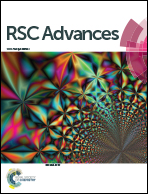Evaluation of the catalytic effect of non-noble bismuth on the lead half-cell reaction for lead-based redox flow batteries
Abstract
Bi3+ ions are introduced into the lead electrolyte of lead-based redox flow batteries (RFBs), and their influence on the electrochemical performance of the redox cell is thoroughly investigated. The metallic Bi particles, which are simultaneously electrodeposited onto the electrode surface during the charge process of the RFBs, significantly improve the electrochemical performance of lead-based RFBs by enhancing the activity and reversibility of the sluggish Pb(II)/Pb(0) redox reaction and suppressing hydrogen evolution. The cell using a negative electrolyte with Bi3+ ions exhibits considerable enhancement both in the columbic efficiency (CE) and voltage efficiency (VE), and therefore in the energy efficiency (EE). Moreover, a mechanism accounting for the role that Bi particles play in the redox reactions in this lead half-cell is proposed. Bi particles favor the formation of a BiHx compound, an intermediate that reduces Pb(II) to Pb(0), and thereby curbs the competitive side reaction of hydrogen evolution responsible for the major loss for the CE. Additionally, the morphology of lead electrodeposition is also presented and the deposits become more uniform and smooth without any dendrites upon the addition of Bi3+. The results suggest that the utilization of non-noble Bi as a high-performance additive promises to be applicable to lead-based RFBs.


 Please wait while we load your content...
Please wait while we load your content...